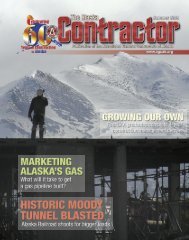The Alaska Contractor: Fall 2006
The Alaska Contractor: Fall 2006
The Alaska Contractor: Fall 2006
Create successful ePaper yourself
Turn your PDF publications into a flip-book with our unique Google optimized e-Paper software.
Even so, the impacts on judicial decision-making were<br />
almost immediate and favorable. A federal District Court in<br />
Texas was considering a case where the Chevron Pipe Line<br />
Company was being fi ned by federal regulators for spilling<br />
oil into a dry creek bed. Although the spill was cleaned up,<br />
as required by state law, and the nearest free fl owing river<br />
was almost 25 miles from the spill.<br />
To make its decision on whether there was federal jurisdiction,<br />
the District Court considered the differing opinions<br />
in Rapanos, and found that Justice Kennedy’s “signifi cant<br />
nexus” approach advanced “an ambiguous test” that left no<br />
guidance on how to determine what is “signifi cant.” <strong>The</strong><br />
judge in this case relied instead on the opinion of the other<br />
four Justices, authored by Justice Scalia, that federal jurisdiction,<br />
under the Clean Water Act, does not extend to drainage<br />
ditches used for rain fl ow.<br />
This may be an excellent start, but it is only just that – a<br />
start. Other courts in other federal circuits are likely to apply<br />
the Rapanos decision differently. In fact, the Ninth Circuit<br />
recently opted to follow the Kennedy application to<br />
defi ne Clean Water Act jurisdiction. It is unlikely then that<br />
the Corps will reduce its permit demands except perhaps<br />
in those situations where the land or water body is wholly<br />
isolated from downstream waters. Even there it is likely the<br />
Corps will continue to “fudge” on its authority.<br />
<strong>The</strong> full impact of Rapanos in <strong>Alaska</strong> is as yet unknown,<br />
but interpretive cases are moving forward. Fairbanks North<br />
Star Borough v. Corps of Engineers Pacifi c Legal Foundation<br />
is challenging claims by the Corps that land frozen solid 12<br />
months of the year is actually a jurisdictional wetland. <strong>The</strong><br />
Corps, acting on an appeal to itself, has upheld its own earlier<br />
jurisdictional determination.<br />
In every state except <strong>Alaska</strong> wetlands permitting jurisdiction<br />
is determined by the Corps using the congressionally<br />
mandated 1987 Wetlands Delineation Manual. <strong>The</strong> <strong>Alaska</strong><br />
District of the Corps, however, developed its own jurisdictional<br />
standard, called <strong>The</strong> <strong>Alaska</strong> Rule, which confers jurisdiction<br />
to the Corps over areas of permafrost like that found<br />
in North Star Borough.<br />
As the lawsuit to reverse the jurisdictional claim to frozen<br />
tundra moves forward, PLF will be asking the court to<br />
remand the <strong>Alaska</strong> Rule back to the Corps with instructions<br />
that it must follow the United States Supreme Court’s ruling<br />
in Rapanos and be made compatible with the 1987 Manual<br />
used elsewhere.<br />
Federal agencies like the Corps of Engineers have been<br />
expanding their powers over local land use issues for decades.<br />
It is unreasonable to believe this trend can be reversed<br />
in one or two cases. This is why Pacifi c Legal Foundation<br />
continues to press a comprehensive legal attack on illegal<br />
federal regulation across the nation.<br />
M. Reed Hopper is a Principal Attorney at Pacifi c Legal<br />
Foundation and represented John Rapanos in Rapanos v. United<br />
States in his successful appeal in the United States Supreme Court.<br />
<strong>Fall</strong> <strong>2006</strong> <strong>The</strong> <strong>Alaska</strong> CONTRACTOR 73

















